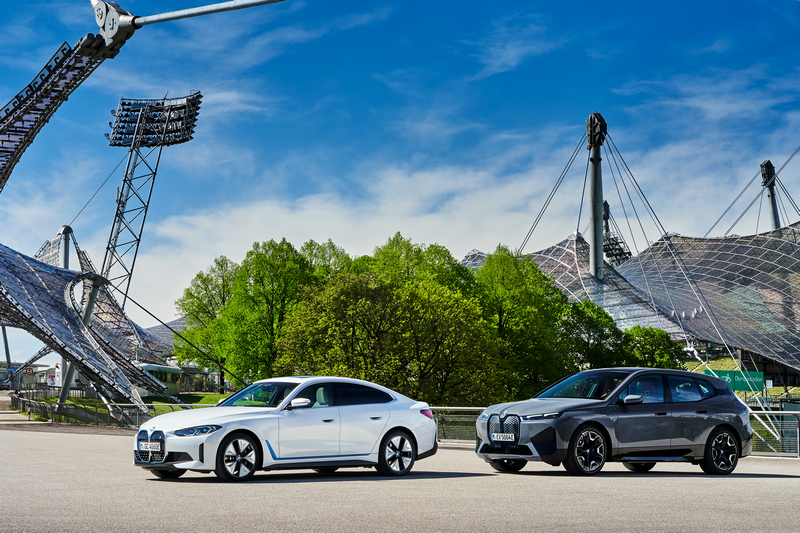Author | Kaijun Qiu
Editor | Kaijun Qiu
BMW is the most resolute and successful luxury brand in the field of electrification transformation so far. On March 16th, BMW Group held its financial results conference and unveiled its latest progress and plans in electrification.
In the 2021 fiscal year, BMW Group’s global new energy vehicle sales increased 70%, exceeding 320,000 units, accounting for 13% of BMW Group’s total sales. In China, BMW Group’s new energy vehicle sales exceeded 48,000 units, a year-on-year increase of 69.6%; from 2014 to the present, BMW Group has accumulated nearly 140,000 new energy vehicles delivered in China.
In terms of total amount, growth rate and level of electrification, it is the leader in the luxury car brands.
So, how will BMW Group promote electrification in the future?
Through financial reports and senior executives’ speeches, we can summarize BMW’s short-term, medium-term, and long-term strategies for electrification.
-
Short-term (2022-2025): BMW still upholds the concept of “the power of choice” and provides internal combustion engines, plug-in hybrids, and pure electric options for the same models.
-
Medium-term (2025-2030): BMW will launch the “New Generation” pure electric architecture models and gradually increase the proportion of pure electric to 50%.
-
Long-term (after 2030): Some of its brands will be fully electrified, supplemented by hydrogen fuel cell as a zero-emission option, but there will still be a certain proportion of internal combustion engine models.
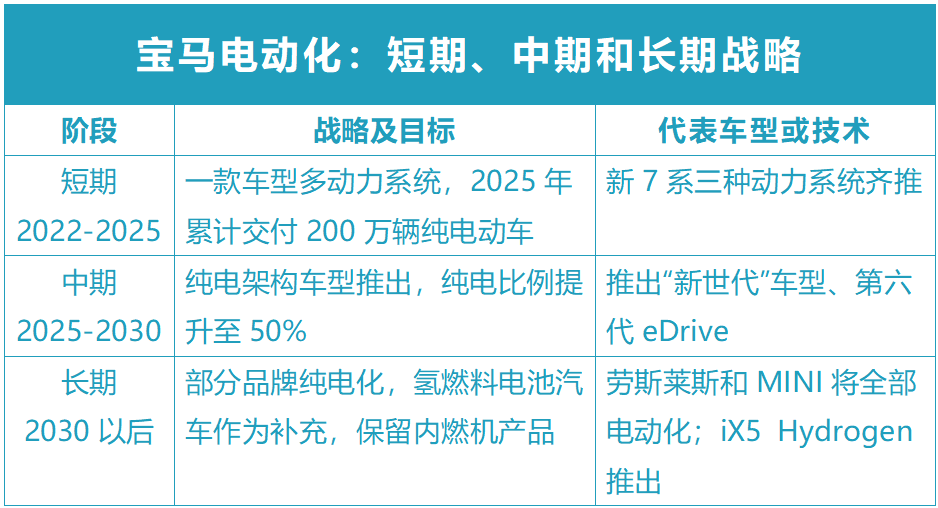
Short-term: One car, multiple power sources strategy continued
The most eye-catching thing at the financial results conference was BMW’s preview of the new i7. This car will be released in April along with the brand new BMW 7 Series.
The BMW i7 is the first pure electric luxury flagship sedan, with a driving range of over 600 kilometers.
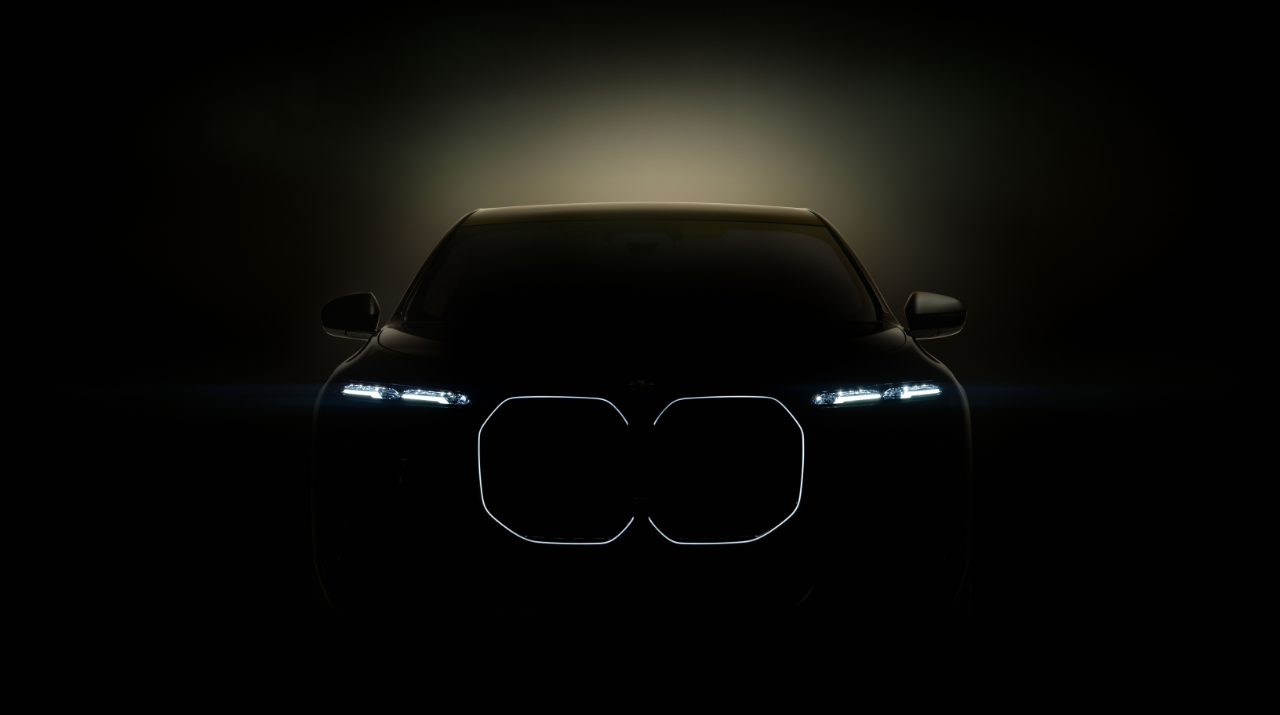
The all-new BMW 7 Series is still bold and innovative in inheriting and breaking through. The size of the kidney grille outline is huge and illuminated by a halo, making it look luxurious and extraordinary. The daytime running lights are composed of luxurious crystal elements, shining like a jewel.
Inside the car, the new 7 Series will feature BMW’s latest digital technology, including Theme Modes and the latest-generation BMW iDrive operating system.The integrated floating curved screen, first used in the iX, will be reintroduced on the all-new 7 Series. The BMW embrace interactive light strip runs through the entire front instrument panel and doors, and integrates function buttons. The roof also features a newly designed panoramic starry sky, which can control the LED light color on the sky according to personal preferences. In addition, an outstanding feature of the all-new BMW 7 series is the introduction of the BMW floating screen in the rear row. The size of the screen is 31 inches, with an ultra-wide ratio of 32:9 and a resolution of up to 8K.
BMW has high hopes for this car. “The success and the strong customer demand for the innovative BMW iX and i4 demonstrate this,” said Oliver Zipse, chairman of the BMW Group. “This year, the pure electric BMW i7 will take BMW’s electric vehicle lineup to new heights. It will be an important part of our continued success and leadership in change.” The all-new BMW 7 series is the next ace in the hole for our successful growth strategy in the luxury car market. This model will become the first luxury sedan in the BMW luxury segment to offer internal combustion engines, plug-in hybrid and pure electric drive.
The all-new BMW 7 series offers three power modes in one car, making it a common strategy for recent BMWs, reflecting Zipse’s philosophy of the “power of choice”. According to Zipse, consumers should decide which driving method to choose, rather than being forced to choose. The BMW X3 was the first model to offer three power systems, including the pure electric iX3, and internal combustion engine and plug-in hybrid versions.
Although the pure electric i3 has not yet been officially released, it has already been included in the announcement of the Ministry of Industry and Information Technology. Other BMW models may not have the same three powertrain options, but many have two powertrain systems to choose from. For example, the BMW 4 Series has both an internal combustion engine version and an all-electric i4 version. The BMW 5 series has both an internal combustion engine and a plug-in hybrid version. X1 and X5 both have internal combustion and plug-in hybrid versions. In addition, BMW also plans to continue to enrich the powertrain system of one model to provide three options. Both BMW 5 Series and X1 will launch pure electric models to achieve the same three powertrain systems.By employing this strategy, the BMW Group will rapidly expand its new energy vehicle product offerings. For example, by 2022, the BMW Group will mass-produce and trial-produce 15 models of pure electric vehicles, covering approximately 90% of the sub-segments.
Moreover, according to Pieter Nota, the BMW Group’s target is to continue promoting electrification through this strategy until 2025. By the end of 2025, they plan to deliver 2 million pure electric cars worldwide.
In addition, in order to ensure the production of existing models, the BMW Group has made sufficient preparations in critical component supply. For example, in order to ensure an adequate supply of battery cells, the BMW Group has increased the procurement volume of battery cells equipped with the fifth-generation eDrive electric drive system from 12 billion euros to over 20 billion euros.
Mid-term: New Generation Pure Electric Models Will Take Off
A strategy BMW is utilizing is to have one model with three types of powertrains. BMW has also recognized that consumer demand is gradually shifting to electric power, and that developing pure electric models will bring relative advantages.
BMW is developing a “New Class” (NEUE KLASSE) model, which is based on a new platform and equipped with the sixth-generation eDrive electric drive system. The first trial production model will roll off the line in 2024, and will be officially launched in 2025.
It seems that BMW’s New Class model is later than the pure electric platforms of many other automakers. However, it should be understood that the New Class model is new inside and out.
First, many automakers have only introduced powertrain platforms. BMW’s pure electric system platform, eDrive, has already been introduced. By the time the New Class model is launched, it will be equipped with the sixth-generation eDrive. The sixth-generation eDrive electric drive system balances performance and cost control, and has a completely new form of chemistry and battery cells, which will result in higher energy density for the battery pack and longer driving range.
BMW has also started developing the seventh-generation eDrive, and will consider how to apply solid-state battery technology.
Second, many models’ platform unification is limited to chassis platforms. The BMW New Class model not only does this, but also has an entirely new design in terms of software for intelligentization. Based on new software and automotive electronic architecture, the BMW New Class model will provide revolutionary innovative design, bringing a digital customer experience.
In addition, BMW will continue to adhere to a new sustainable concept of utilizing reusable materials throughout the lifecycle of the vehicle, promoting circular economy.
Therefore, the BMW New Class model is a new architecture concept, which not only has more prominent performance, functionality and experience, but is also more environmentally friendly and effectively reduces per-vehicle costs.
After the New Class model is launched in 2025, the BMW new architecture will definitely be widely enabled across various sub-brands and models, forming a batch of competitive intelligent electric products.
Aiming to Deliver 10 Million EVs, BMW Group will Electrify its Three Major Brands by 2030
BMW Group plans to deliver 10 million pure electric vehicles by 2030. Besides, its three major brands, Rolls-Royce, BMW Motorrad, and MINI, will be fully electrified. Rolls-Royce will complete the electrification of all of its products, while BMW Motorrad urban mobility series will achieve full electrification. MINI brand will start its full electrification in the early 2030s.
“By 2030, at least 50% of the global sales will be pure electric cars. We are doing everything we can to achieve this goal ahead of time. By then, the annual sales of pure electric cars will exceed 1.5 million,” said Zipse.
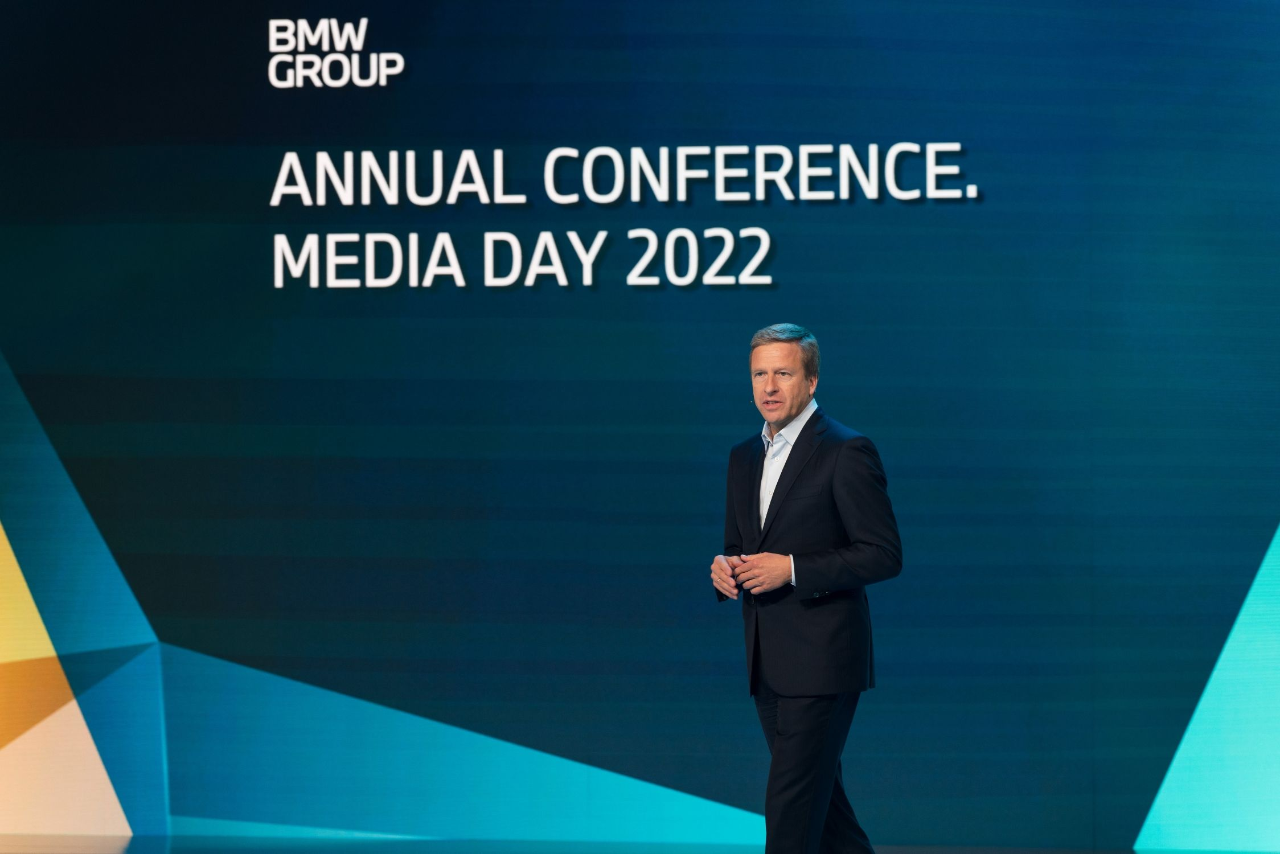
Future Plan: Both Pure Electric and Hydrogen Fuel Cell Vehicles
After surpassing the threshold of 50% market share for pure electric vehicles by 2030, BMW Group will still provide hydrogen fuel cell vehicles as a significant supplement to electric vehicles. Hydrogen fuel cell vehicles are also another focus of BMW’s new energy technologies. BMW and Toyota, who are devoted to hydrogen fuel, have established a close cooperation.
This year, BMW’s ix5 Hydrogen Fuel Cell Vehicle will undergo small-scale production. bmw has just announced that it has tested ix5 Hydrogen in extremely cold weather in Sweden, and the newly-made car can reach a maximum range of 500 kilometers in extreme cold conditions. In addition, it can fill the hydrogen tank in 3-4 minutes.
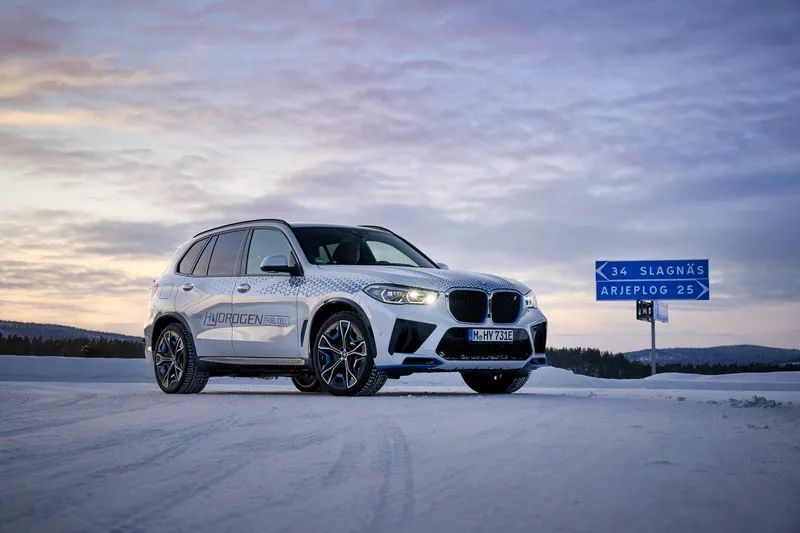
On the new generation of models officially launched in 2025, there will also be models based on hydrogen fuel cell technology, giving consumers another choice for sustainable travel. BMW estimates that the proportion of hydrogen fuel cell technology in the powertrain system combination will become increasingly important since the second half of the 2020s.
BMW is not only betting on pure electric vehicles, but it is not completely eliminating the internal combustion engine either. Unlike some automakers who have stopped developing engines or draw the timeline of its abandonment, BMW insists on developing engines. Frank Weber, BMW’s head of development, emphasized at the beginning of this year, that new engines need to be developed to reduce carbon emissions effectively. BMW is also preparing a new engine factory.
Therefore, BMW will provide products equipped with an internal combustion engine not only in the short, medium but even long term. Internally combustible engines will become less used over time, and their fuel efficiency will increase significantly.## BMW Brilliance Merger Will Bring Financial Benefits of EUR 7-8 Billion
Since it is a financial report conference, the business performance of companies is the focus. In 2021, BMW, led by Zipse, achieved excellent results.
BMW Group’s global sales in 2021 exceeded 2.52 million units, an increase of 8.4% compared with the same period last year; BMW sold 846,000 units in China (including the MINI brand), an increase of 8.9% year-on-year, ranking first among Chinese luxury brands.
BMW’s total revenue in the fiscal year of 2021 reached EUR 111.239 billion, an increase of 12.4% year-on-year. At the same time, net profit reached EUR 12.463 billion, an increase of 223.1% year-on-year.
In 2022, unfavorable factors such as the Ukrainian war, chip shortage, and soaring material prices have appeared globally. However, Zipse stated that BMW’s sales this year are expected to remain flat with those in 2021, and there will be no significant decline. BMW also lowered its profit margin expectation for the automotive sector in 2022, expecting the pre-tax profit margin (EBIT) of its automotive business to fall between 7% and 9% this year.
In terms of financial performance in 2022, BMW will have a significant advantage.
Since February 11 of this year, the BMW Group will hold 75% equity in the joint venture company Brilliance BMW, while Brilliance China’s equity ratio will change to 25%, and the effective period of the new joint venture company will be extended to 2040. With the change of equity, Brilliance BMW will be included in the report of the group, which will bring more than EUR 7 billion in financial performance to BMW Group.
Introduction of iFACTORY Standards
At the financial report conference, BMW Group also proposed a new standard for the production network – BMW iFACTORY. BMW iFACTORY standards will be applied in all BMW Group factories worldwide, including three vehicle assembly factories and one powertrain factory in Shenyang production base.
By launching iFACTORY, BMW expects to provide a globalized solution for the transformation of the production network in the electric era.
BMW’s first iFACTORY will be the Debrecen factory in Hungary. This factory is scheduled to start construction in June this year. Twenty-six months later, the trial production of “new generation” models will be launched here. In 2025, “new generation” models will be officially put into production at the factory.
iFACTORY can be said to be born out of electric vehicles but will be applied to all BMW factories.
Zipse said: “With the official launch of the ‘new generation’ models in 2025, BMW Group’s production network will enter a new dimension, which we call BMW iFACTORY. Each BMW factory is ready for this.”The most prominent feature of iFACTORY is its green profile, aiming to achieve production through the latest technologies, minimal resource consumption and circular economy.
BMW Group’s target is to reduce carbon emissions per vehicle in production by 80% by 2030 compared to 2019.
Overall, BMW is both proactive and pragmatic in electrification, continually progressing in accordance with its own strategy. To support electrification, BMW has developed strategic support in research and development, procurement, production, sales, service, and finance. In response to the challenges of electrification, BMW has shown its organizational system capabilities and flexibility.
——END——
This article is a translation by ChatGPT of a Chinese report from 42HOW. If you have any questions about it, please email bd@42how.com.
